Related Research Articles

Agriculture encompasses crop and livestock production, aquaculture, fisheries and forestry for food and non-food products. Agriculture was the key development in the rise of sedentary human civilization, whereby farming of domesticated species created food surpluses that enabled people to live in cities. While humans started gathering grains at least 105,000 years ago, nascent farmers only began planting them around 11,500 years ago. Sheep, goats, pigs and cattle were domesticated around 10,000 years ago. Plants were independently cultivated in at least 11 regions of the world. In the twentieth century, industrial agriculture based on large-scale monocultures came to dominate agricultural output.

A drought is defined as drier than normal conditions. This means that a drought is "a moisture deficit relative to the average water availability at a given location and season". A drought can last for days, months or years. Drought often exerts substantial impacts on the ecosystems and agriculture of affected regions, and causes harm to the local economy. Annual dry seasons in the tropics significantly increase the chances of a drought developing and subsequent wildfires. Periods of heat can significantly worsen drought conditions by hastening evaporation of water vapour.
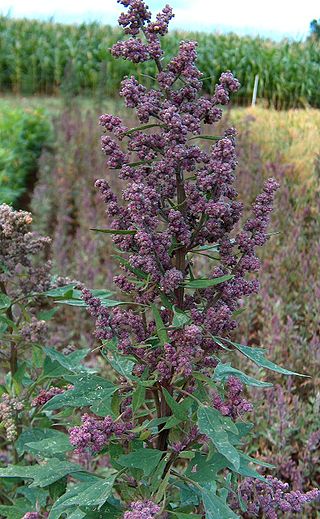
Quinoa is a flowering plant in the amaranth family. It is a herbaceous annual plant grown as a crop primarily for its edible seeds; the seeds are rich in protein, dietary fiber, B vitamins, and dietary minerals in amounts greater than in many grains. Quinoa is not a grass, but rather a pseudocereal botanically related to spinach and amaranth, and originated in the Andean region of northwestern South America. It was first used to feed livestock 5,200–7,000 years ago, and for human consumption 3,000–4,000 years ago in the Lake Titicaca basin of Peru and Bolivia.
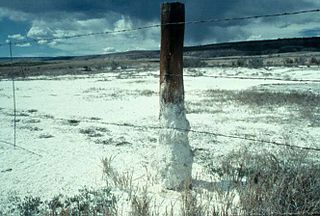
Soil salinity is the salt content in the soil; the process of increasing the salt content is known as salinization. Salts occur naturally within soils and water. Salination can be caused by natural processes such as mineral weathering or by the gradual withdrawal of an ocean. It can also come about through artificial processes such as irrigation and road salt.
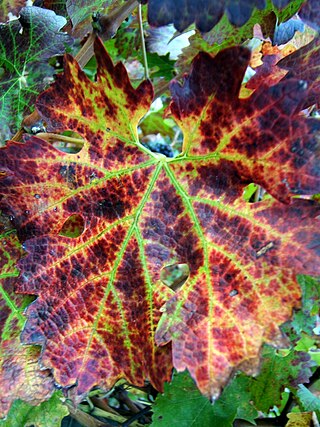
Physiological plant disorders are caused by non-pathological conditions such as poor light, adverse weather, water-logging, phytotoxic compounds or a lack of nutrients, and affect the functioning of the plant system. Physiological disorders are distinguished from plant diseases caused by pathogens, such as a virus or fungus. While the symptoms of physiological disorders may appear disease-like, they can usually be prevented by altering environmental conditions. However, once a plant shows symptoms of a physiological disorder it is likely that, that season's growth or yield will be reduced.

Agricultural productivity is measured as the ratio of agricultural outputs to inputs. While individual products are usually measured by weight, which is known as crop yield, varying products make measuring overall agricultural output difficult. Therefore, agricultural productivity is usually measured as the market value of the final output. This productivity can be compared to many different types of inputs such as labour or land. Such comparisons are called partial measures of productivity.

Sustainable agriculture is farming in sustainable ways meeting society's present food and textile needs, without compromising the ability for current or future generations to meet their needs. It can be based on an understanding of ecosystem services. There are many methods to increase the sustainability of agriculture. When developing agriculture within sustainable food systems, it is important to develop flexible business process and farming practices. Agriculture has an enormous environmental footprint, playing a significant role in causing climate change, water scarcity, water pollution, land degradation, deforestation and other processes; it is simultaneously causing environmental changes and being impacted by these changes. Sustainable agriculture consists of environment friendly methods of farming that allow the production of crops or livestock without damage to human or natural systems. It involves preventing adverse effects to soil, water, biodiversity, surrounding or downstream resources—as well as to those working or living on the farm or in neighboring areas. Elements of sustainable agriculture can include permaculture, agroforestry, mixed farming, multiple cropping, and crop rotation.

Nutrient management is the science and practice directed to link soil, crop, weather, and hydrologic factors with cultural, irrigation, and soil and water conservation practices to achieve optimal nutrient use efficiency, crop yields, crop quality, and economic returns, while reducing off-site transport of nutrients (fertilizer) that may impact the environment. It involves matching a specific field soil, climate, and crop management conditions to rate, source, timing, and place of nutrient application.

Chenopodium pallidicaule, known as cañihua, canihua or cañahua and also kaniwa, is a species of goosefoot, similar in character and uses to the closely related quinoa(Chenopodium quinoa).
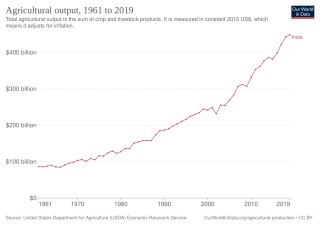
The history of agriculture in India dates back to the neolothic. India ranks second worldwide in farm outputs. As per Indian economic survey 2018, agriculture employed more than 50% of the Indian work force and contributed 17–18% to country's GDP.

Soil salinity control relates to controlling the problem of soil salinity, with the aim of preventing soil degradation by salination and reclamation of already salty (saline) soils. Soil reclamation is also called soil improvement, rehabilitation, remediation, recuperation or amelioration.
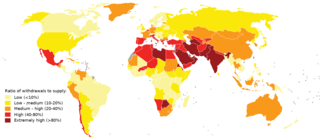
Water scarcity is the lack of fresh water resources to meet the standard water demand. There are two types of water scarcity: physical water scarcity and economic water scarcity. Physical water scarcity is where there is not enough water to meet all demands, including that needed for ecosystems to function. Arid areas for example Central and West Asia, and North Africa often suffer from physical water scarcity. On the other hand, economic water scarcity is the result of a lack of investment in infrastructure or technology to draw water from rivers, aquifers, or other water sources, or insufficient human capacity to meet the demand for water. Much of Sub-Saharan Africa has economic water scarcity.
Upland rice is a type of rice grown on dry soil rather than flooded rice paddies. It is sometimes also called dry rice.
Water-use efficiency (WUE) refers to the ratio of water used in plant metabolism to water lost by the plant through transpiration. Two types of water-use efficiency are referred to most frequently:
Breeding for drought resistance is the process of breeding plants with the goal of reducing the impact of dehydration on plant growth.
National Innovations in Climate Resilient Agriculture (NICRA) was launched during February 2011 by Indian Council of Agricultural Research (ICAR) with the funding from Ministry of Agriculture, Government of India. The mega project has three major objectives of strategic research, technology demonstrations and capacity building. Assessment of the impact of climate change simultaneous with formulation of adaptive strategies is the prime approach under strategic research across all sectors of agriculture, dairying and fisheries.

The effects of climate change on agriculture can result in lower crop yields and nutritional quality due to drought, heat waves and flooding as well as increases in pests and plant diseases. The effects are unevenly distributed across the world and are caused by changes in temperature, precipitation and atmospheric carbon dioxide levels due to global climate change. In 2019, millions were already suffering from food insecurity due to climate change. Further, the predicted decline in global crop production is 2% - 6% with each decade. In 2019 it was predicted that food prices would rise by 80% by 2050. This will likely lead to increased food insecurity, disproportionally affecting poorer communities. A 2021 study estimated that the severity of heatwave and drought impacts on crop production tripled over the last 50 years in Europe – from losses of 2.2% during 1964–1990 to losses of 7.3% in 1991–2015.

Salt tolerance of crops is the maximum salt level a crop tolerates without losing its productivity while it is affected negatively at higher levels. The salt level is often taken as the soil salinity or the salinity of the irrigation water.
Climate change and agriculture are complexly related processes. In the United States, agriculture is the second largest emitter of greenhouse gases (GHG), behind the energy sector. Direct GHG emissions from the agricultural sector account for 8.4% of total U.S. emissions, but the loss of soil organic carbon through soil erosion indirectly contributes to emissions as well. While agriculture plays a role in propelling climate change, it is also affected by the direct and secondary consequences of climate change. USDA research indicates that these climatic changes will lead to a decline in yield and nutrient density in key crops, as well as decreased livestock productivity. Climate change poses unprecedented challenges to U.S. agriculture due to the sensitivity of agricultural productivity and costs to changing climate conditions. Rural communities dependent on agriculture are particularly vulnerable to climate change threats.
HB4 wheat is a type of wheat that has been genetically modified by introducing sunflower genes, with the objective of improving crop productivity. Wheat, along with corn and soybeans, constitute the basis of world food, and different scientific research was focused on improving its productivity. The improvements in food production achieved in the 90's agricultural production could equal the food demand of the world population, thanks to different technological improvements.
References
- ↑ English, M., (1990). Deficit Irrigation. I: Analytical Framework. J. Irrig. Drain. E.-ASCE 116, 399-412.
- ↑ Fereres, E., Soriano, M.A., (2007).Deficit irrigation for reducing agricultural water use J. Exp. Bot. 58, 147-158
- ↑ Kipkorir, E.C., Raes, D., Labadie, J., (2001). Optimal allocation of short-term irrigation supply. Irrig. Drain. Syst. 15, 247-267.
- 1 2 Geerts, S., Raes, D., (2009). Deficit irrigation as an on-farm strategy to maximize crop water productivity in dry areas. Agric. Water Manage 96, 1275-1284
- ↑ Kijne, J.W., Barker, R., Molden, D., (2003). Improving water productivity in agriculture: editor's overview. In: Kijne, J.W., Barker, R.M.D. (eds.), Water productivity in agriculture: limits and opportunities for improvement. International Water Management Institute, Colombo, Sri Lanka, p. xi-xix.
- ↑ Zwart, S.J., Bastiaanssen, W.G.M., (2004). Review of measured crop water productivity values for irrigated wheat, rice, cotton and maize. Agric. Water Manage 69, 115-133.
- ↑ Ilbeyi, A., Ustun, H., Oweis, T., Pala, M., Benli, B., (2006). Wheat water productivity and yield in a cool highland environment: Effect of early sowing with supplemental irrigation. Agric. Water Manage 82, 399-410.
- ↑ Raes, D., Geerts, S., Vandersypen, K., (2008). More Food, Less Water. In: Raymaekers, B. (ed.), Lectures for the XXIst century. Leuven University Press, Leuven, Belgium, p. 81-101.
- ↑ Geerts, S., Raes, D., Garcia, M., Vacher, J., Mamani, R., Mendoza, J., Huanca, R., Morales, B., Miranda, R., Cusicanqui, J., Taboada, C., (2008). Introducing deficit irrigation to stabilize yields of quinoa (Chenopodium quinoa Willd. '). Eur. J. Agron. 28, 427-436.
- ↑ Spreer, W., Ongprasert, S., Hegele, M., Wünnsche, J. N., Müller, J. (2009). Yield and fruit development in mango (Mangifera indica L. cv. Chok Anan) under different irrigation regimes. Agric. Water Manage 96, 574-584.
- ↑ USDA 2010
- ↑ "New Farming Wrinkle May Help Peanut Growers". USDA Agricultural Research Service. January 14, 2010.
- ↑ Pandey, R.K., Maranville, J.W., Admou, A., (2000). Deficit irrigation and nitrogen effects on maize in a Sahelian environment. I. Grain yield and yield components. Agric. Water Manage. 46, 1-13.
- ↑ Steduto, P., Hsiao, T. C., Fereres, E., (2007) On the conservative behavior of biomass water productivity. Irrig. Sci. 25, 189-207.
- ↑ Steduto, P., Albrizio, R., (2005). Resource use efficiency of field-grown sunflower, sorghum, wheat and chickpea. II. Water use efficiency and comparison with radiation use efficiency. Agric. Forest Meteorol. 130, 269-281.
- ↑ Pereira, L.S., Oweis, T., Zairi, A., (2002). Irrigation management under water scarcity. Agric. Water Manage 57, 175-206.
- ↑ Ünlü, M., Kanber, R., Senyigit, U., Onaran, H., Diker, K., (2006). Trickle and sprinkler irrigation of potato (Solanum tuberosum L.) in the middle Anatolian region in Turkey. Agric. Water Manage 79, 43-71.
- ↑ Pandey, R.K., Maranville, J.W., Chetima, M.M., (2000). Deficit irrigation and nitrogen effects on maize in a Sahelian environment. II. Shoot growth, nitrogen uptake and water extraction. Agric. Water Manage 46, 15-27.
- ↑ Geerts, S., Raes, D., Garcia, M., Mendoza, J., Huanca, R., (2008). Indicators to quantify the flexible phenology of quinoa (Chenopodium quinoa Willd. ) in response to drought stress. Field Crop. Res. 108, 150-156.
- ↑ Hsiao, T.C., (1973). Plant Responses to Water Stress. Annu. Rev. Plant Physiol. 24, 519-570.
- ↑ Kirda, C., (2002). Deficit irrigation scheduling based on plant growth stages showing water stress tolerance. In: Food and Agricultural Organization of the United Nations (FAO) (ed.), Deficit irrigation practices. Rome, Italy, p. 3-10.
- ↑ Zhang, H., (2003). Improving water productivity through deficit irrigation: examples from Syria, the North China Plain and Oregon, USA. In: Kijne, J.W., Barker, R., Molden, D. (eds.), Water productivity in agriculture: limits and opportunities for improvement. International Water Management Institute, Colombo, Sri Lanka, p. 301-309.
- ↑ Zhang, H., Oweis, T., (1999). Water-yield relations and optimal irrigation scheduling of wheat in the Mediterranean region. Agric. Water Manage 38, 195-211.
- ↑ Kang, S., Zhang, L., Liang, Y., Hu, X., Cai, H., Gu, B., (2002). Effects of limited irrigation on yield and water use efficiency of winter wheat in the Loess Plateau of China. Agric. Water Manage 55, 203-216.
- ↑ Geerts, S., Raes, D., Garcia, M., Condori, O., Mamani, J., Miranda, R., Cusicanqui, J., Taboada, C., Vacher, J., (2008). Could deficit irrigation be a sustainable practice for quinoa (Chenopodium quinoa Willd.) in the Southern Bolivian Altiplano? Agric. Water Manage 95, 909-917.
- ↑ Raes, D., Steduto, P., Hsiao, T. C., Fereres, E. (2009) AquaCrop--The FAO Crop Model to Simulate Yield Response to Water: II. Main Algorithms and Software Description. Agron. J. 101, 438-447.
- ↑ Steduto, P, Hsiao, T. C., Raes, D., Fereres, E. (2009). AquaCrop--The FAO Crop Model to Simulate Yield Response to Water: I. Concepts and Underlying Principles. Agron. J. 101, 426-437.